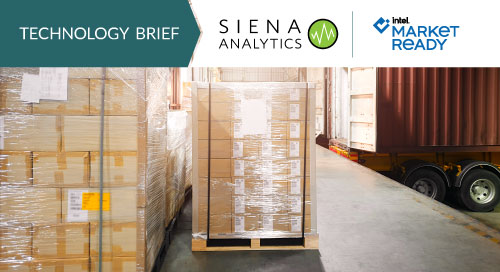Fill form to unlock content
Error - something went wrong!
Stay up-to-date with the latest IoT news.
Subscribed.
AI Unlocks Supply Chain Logistics

Most of us think of the supply chain as a single colossal entity—the Ever Given cargo ship stuck in the Suez Canal comes readily to mind—when it is really made up of many elements. Logistics, the minutia of moving products, comprises a significant component of the supply chain.
Headaches in shipping logistics are aplenty. For example, packages might be delayed or never reach their final destination for a variety of reasons. In 1990, more than 20 containers of Nike shoes fell off a cargo ship traveling from South Korea to the United States. But in the real-life trenches of shipping logistics, packages get delayed for reasons that are a lot less splashy. A smudged barcode or a label that simply falls off a package can hold up delivery—and these seemingly trivial reasons add up to a major headache for enterprises.
The Automation Challenge in Supply Chain Analytics
“The biggest strains on today’s logistics are related to package volume and velocity,” says John Dwinell, Founder and CEO of Siena Analytics, a company that delivers supply chain AI and image recognition for high-volume logistics.
A surge in the number of packages passing through distribution centers and warehouses is especially challenging, because it comes at a time when consumer demand for speedy delivery has also increased. Nearly a third of U.S. consumers have higher expectations for faster shipping since the beginning of the pandemic, according to a 2021 survey.
These dual factors, coupled with ongoing labor shortages, make the case for automation and digital transformation in distribution centers and warehouses. “Unfortunately, attempts at automation are hampered by package quality problems,” Dwinell says.
For example, barcodes that need to be read might be hidden under plastic or missing altogether. Poor quality leads to inconsistencies, which makes automation more difficult. In an automated distribution center, problem packages get routed to a “hospital lane” where workers have to diagnose and troubleshoot the issue. These hiccups tie up valuable worker resources and lose valuable time, neither of which enterprises can afford.
“Siena is leveraging the strengths that #AI algorithms bring to a common set of #logistics problems.” – John Dwinell, @SienaAnalytics via @insightdottech
Solving Automation Challenges With AI
Siena Analytics tackles everything from parcel quality-related obstacles to logistics automation by using sensors in scanning tunnels. Cameras capture images of parcels as they enter and travel around the distribution center. By using AI models to analyze the pictures, the platform troubleshoots problems in real time and delivers long-term parcel intelligence that enterprises can act on.
At the edge, the Siena Analytics solution automates troubleshooting tasks that might otherwise have been moved to the hospital lane. For example, an oversized package might need a specific type of shipping label. Sensors can identify the product size and alert a machine to print the right label. Similarly, if a label falls off, cameras can identify the package through some other distinguishing feature, track the parcel in its cache of earlier photographs, and generate a new label.
AI can also deliver pattern intelligence to detect inconsistencies faster. For example, a vendor found to consistently mislabel images can be trained on a vendor compliance program. Package intelligence can feed a digital twin of the distribution center, which gives visibility at scale. Enterprises can pinpoint bottlenecks in specific machines and sorting tunnels more easily and set up the system to issue alerts when necessary. “You have smarter insights into the good, the bad, and the ugly of what’s happening in the building,” Dwinell says.
Low-Code Platform Eases AI Training
Siena helps companies set up their own AI-driven package intelligence solutions on the back of its low-code Siena Insights platform. Enterprises, Dwinell points out, understand their domain well but lack the tools and know-how to capture the right data for insights. Siena has taken the really intimidating parts of AI and automated those workflows.
Company experts simply lean on their domain expertise to label the data from images that the Siena solution captures, and train and build custom AI solutions. “We have a platform that allows you to train AI models without having to be an expert data scientist yourself,” Dwinell says.
Siena Analytics relies on the Intel® Edge industrial platform to orchestrate the volumes of data and the Intel® OpenVINO™ Toolkit, “that can adapt to whatever hardware is available,” says Dwinell. “OpenVINO allows us to have a common and scalable efficient platform for inferences at the edge.”
By starting with simple data analytics solutions, Siena helps customers bridge the OT-IT divide. Because its solution delivers immediate results that boost the bottom line, systems integrators can make the case for its use to the C-suite. “SIs are particularly impressed by data velocity and our ability to show real results,” Dwinell says.
The Future of Supply Chain Logistics
Expect more standardization of processes—labeling, information in barcodes—in the near future. Robotics-based solutions are also going to mature and be more usable in warehouses, Dwinell predicts. AI is a transformative technology, which will continue to reshape logistics. Already, it is streamlining processes and ironing out inefficiencies in the wider supply chain.
Too often, package information comes from the shippers and does not always align with reality. An AI-based solution like Siena Insights flips that approach on its head. Discrepancies between what shippers say they have done and what the packages actually show can easily be found and fixed. When data comes from the sensors, it’s live and uncontested it’s real. It can be matched and corrected.
“Siena is leveraging the strengths that AI algorithms bring to a common set of logistics problems,” Dwinell says. And when every second in the distribution center counts, every bottleneck resolved is a logistics win.
This article was edited by Georganne Benesch, Associate Editorial Director for insight.tech.